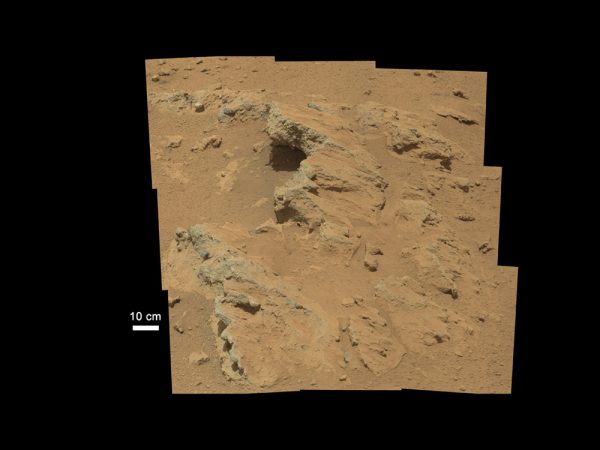Curiosity’s watery find
Mars rover finds rocks that show where water once flowed

Since August, NASA’s Curiosity rover has been exploring a giant Martian crater with a mountain in the middle. In late September, scientists announced that if the rover had landed there 3.5 billion years ago, it might have landed with a splash. Curiosity seems to have landed right in the middle of a former streambed.
The moving water would have been “from ankle to hip deep, and maybe moving a few feet a second,” William Dietrich told Science News. Dietrich is a planetary scientist on the Curiosity mission.
Finding water on Mars is no surprise: Previous studies had turned up evidence that long ago the “Red Planet” may have had streams, rivers, oceans and plenty of rain. Images and other data collected from previous orbiting missions suggested that the giant crater probably contained water billions of years ago. Still, the scientists who work on Curiosity say they’re glad evidence for water came so early in the rover’s mission.
“It is exactly the reason we chose this landing site,” John Grotzinger told Science News. He works at the California Institute of Technology in Pasadena. There, he’s a project scientist on the Curiosity mission.
Curiosity had been analyzing nearby rocks. It found conglomerates. These are rocks that form when pebbles and sand get stuck together with wet sediment. That sediment is the solid material that settles at the bottom of a river or stream. Curiosity has found conglomerates at two sites thus far. At the second site, the conglomerate rocks were about the size of plain M&M’s.
“These are too large to be transported by wind,” says Rebecca Williams. She’s a planetary scientist at the Planetary Science Institute in Tucson, Ariz. “The consensus is that these are water-transported gravels,” she told Science News.
Scientists still don’t know where the water came from — from melting ice or rainfall, for example. They suspect that water flowed into the crater from a large canyon.
Curiosity’s mission is to search for signs of life — even those left by long-gone organisms. Life as we know it requires water, so finding water is an important first step. But Curiosity has a long way to go: It will also be looking for the molecules that make life possible.
Power Words
conglomerate A rough rock composed of rounded fragments generally greater than two millimeters in diameter stuck in finer sediment.
crater A bowl-shaped depression. It can be found at the top of a volcano or in the ground at the site of an explosion or the impact of a meteorite.
NASA rover A carlike vehicle designed to travel across the surface of the moon or some planet without the need for a human driver. Some rovers can also perform computer-driven science experiments.
sediment Matter that settles to the bottom of a liquid.







